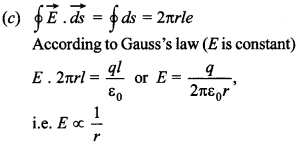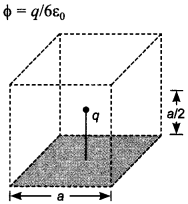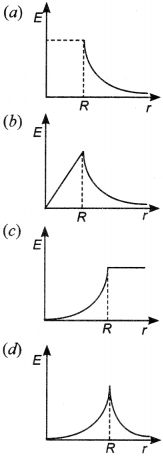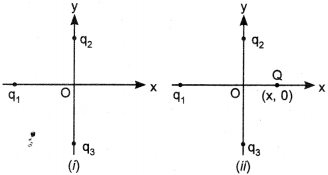Electric Charges and Fields Class 12 Physics MCQs Pdf
13. An electric charge q is placed at the centre of a cube of side a. The electric
flux on one of its faces will be

Answer/Explanation
Answer:
Explaination: (a) Using Gauss’s theorem
14. Total electric flux coming out of a unit positive charge kept in air is

Answer/Explanation
Answer: b
Explaination:
(b) Total flux coming out from the unit charge is
![]()
15. The electric field intensity due to an infinite cylinder of radius R and having
charge q per unit length at a distance rir r(r > R) from its axis is
(a) directly proportional to r².
(b) directly proportional to r3.
(c) inversely proportional to r.
(d) inversely proportional to r².
Answer/Explanation
Answer: c
Explaination:

16. A point charge q is placed at a distance a/2 directly above the centre of a
square of side a. The electric flux through the square is
![]()
Answer/Explanation
Answer: d
Explaination:
(d) An imaginary cube can be made by considering charge q at the centre and
given square is one of its face. So flux through the given square (i.e. one
face)

17. Which of the following graphs shows the variation of electric field E due to a
hollow spherical conductor of radius R as a function of distance from the centre of
the sphere?

Answer/Explanation
Answer: a
Explaination:
(a) Electric field due to a hollow spherical conductor is governed by equations
E = 0, for r < R …(i)
and \(E=Q / 4 \pi \varepsilon_{0} r^{2}\) for r ≥ R ….(ii)
i.e. inside the conductor, electric field will be zero and outside the conductor
it will vary according to E oc 1/r².
18. The magnitude of electric field intensity E is such that, an electron placed in
it would experience an electrical force equal to its weight is given by
(a) mge
(b) mg/e
(c) e/mg
(d) e²g/m²
Answer/Explanation
Answer: b
Explaination: (b) According to the question, eE = mg or E = mg/e
19. In Fig. (i) two positive charges q2 and q3 fixed along the
y-axis, exert a net electric force in the +x direction on a charge q1
fixed along the x-axis. If a positive charge Q is added at (x, 0) in figure (ii),
the force on q1 is [NCERT Exemplar]

(a) shall increase along the positive x-axis.
(b) shall decrease along the positive x-axis.
(c) shall point along the negative x-axis.
(d) shall increase but the direction changes because of the intersection of Q with
q2 and qy
Answer/Explanation
Answer: a
Explaination:
(a) The net electrostatic force on the charge q1 by the charges
q2 and q3 is along the positive x-direction. Hence the
nature of force between qu q2 and qx, q3 should be attractive. It means qx
should be negative.
20. Which of the following statement is correct? The electric field at a point is
[NCERT Exemplar]
(a) always continuous.
(b) continuous if there is a charge at that point.
(c) discontinuous only if there is a negative charge at that point.
(d) discontinuous if there is a charge at that point.
Answer/Explanation
Answer: d
Explaination:
(d) The electric field due to any charge will be continuous, if there is no
other charge in the medium. It will be discontinuous if there is a charge at the
point under consideration.
21. A point charge +q is placed at a distance d from an isolated conducting plane.
The field at a point P on the other side of the plane is [NCERT Exemplar]
(a) directed perpendicular to the plane and away from the plane.
(b) directed perpendicular to the plane but towards the plane.
(c) directed radially away from the point charge.
(d) directed radially towards the point charge.
Answer/Explanation
Answer: a
Explaination:
(a) The electric field lines are away from positive charge and perpendicular to
the surface. Hence the field at a point P on the other side of the plane is
directed perpendicular to the plane and away from the plane.
22. Gauss’s law will be invalid if
(a) there is magnetic monopoles.
(b) the inverse square law is not exactly true.
(c) the velocity of light is not a universal constant.
(d) none of these.
Answer
Answer: b
23. SI unit of permittivity of free space is
(a) Farad
(b) Weber
(c) C2N-1 m-2
(d) C2N-1 m-2
Answer
Answer: c
24. A charge Q is placed at the centre of the line joining two point charges +q and
+q as shown in the figure. The ratio of charges Q and q is
![]()
(a) 4
(b) 1/4
(c) -4
(d) -1/4
Answer
Answer: d